To document this song, I’m going to build the song up, adding parts, FX, and automation to show how the song developed to me as the producer.
To start with, I created the drum parts first, plotting the midi parts out and listening to all the drums together until I was happy that all the parts worked together rhythmically. Each different part of the song includes different drum parts, this gives the track a rhythmical variation, which keeps things interesting to the listener as the song continues.
Drums:
Intro/Build 1:
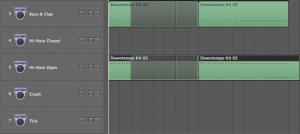
As you can see in this picture, the drums begin very simple, with only a clap and open hi hat that you would see in the standard house drum beat, with the bass drum on every beat (Although there is no bass part in this, this is because I felt it gave the drop a harder feeling as the less bass parts there are before a drop, the more the bass will hit after it. I also feel like the rhythmical effect it has, works better without the bass drum in this part.), the clap on every second and fourth beat, and an open hi-hat in on the ‘&’ of each beat.
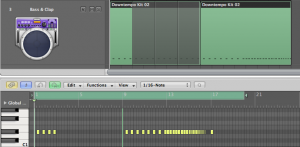
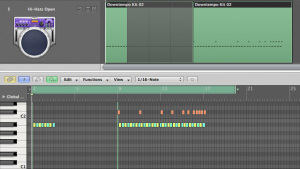
Here is a bounce of the drums depicted here, with no FX or automation:
Build 2:
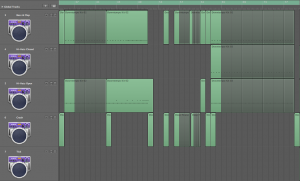
In the second build up, the dynamics have completely changed, so I can bring in more drums for the build up. So now there is also a bass drum, and a crash.

For the bass drum, it plays the same part all the time, hitting once on every beat. This is the same throughout the entire song. The same goes for the clap, except on every second and fourth beat.

The open hi-hats are playing the same part they did in the first build up, hitting on the ‘&’ of every beat.

The crash works to accent the other parts in the build up. As it is a long, high pitched piece of percussion, it helps to build tension by creating a ‘pad’ of sorts.
This build up creates extra tension by including a ‘false’ drop, where everything builds up and another part plays to build up to the drop again. During this false drop everything drops out of the drums, apart from the clap and the crash. They are used sparingly in between the bass parts that play at that time to create extra tension.
Here is a bounce of the drums depicted here, with no FX or automation:
Build 3/Breakdown:
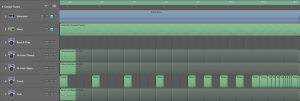
For the third build up, my intentions were similar to the first build up. I took the bass drum and removed it from the equation.

I then used the crash in a similar way to the second build up, having it hit more and more often to create a richer, high end pad that helps create tension before the drop.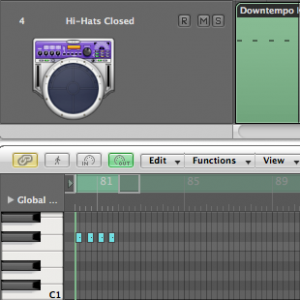

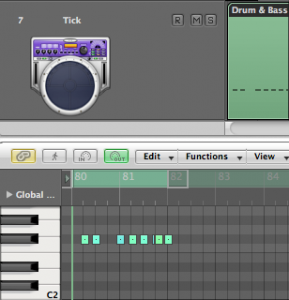
Everything else, however, is playing the same part it plays in the chorus. However, these parts, without the bass drum, actually create the ideal rhythmical effect that I wanted for this part, as the lack of a bass drum gives this part a much more open feeling.
Here is a bounce of the drums depicted here, with no FX or automation:
Chorus/Drop:
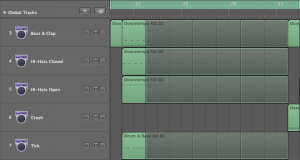
This part is identical to the third build up, apart from the crash, which plays a different part as it is used with a different intention.

The bass drum hits on every beat whilst the clap hits on every second and fourth beat. Every time the bass drum is used, it plays this part. However, the clap is used to compliment the crash in the second build up, with different timing.
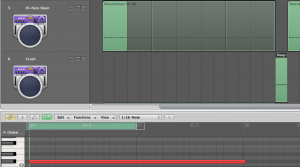
The crash only hits at the end of the chorus as it is used with the risers to create a pad of sound for when the chorus drops out.
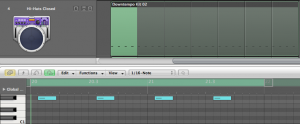
The closed hi-hats are used to accent the open hi-hats, hitting a sixteenth note before the open hi-hats. This creates a ‘skippy’ feeling that is used a lot in garage/house music to create an interesting rhythm.
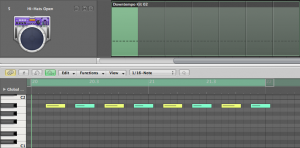
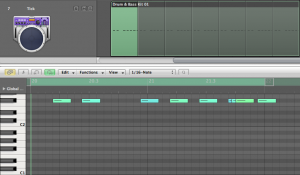
The tick is used to accent all the other drum parts. This part is influenced by trap music, where a sharp ‘tick’ sound is used in quick bursts, I used the same technique alongside some more accenting after the open hi-hats, similar to the closed hi-hat I used.
Here is a bounce of the drums depicted here, with no FX or automation:
Effects:
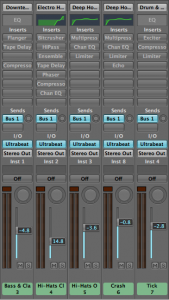
The main effects I used included:
- Compression & Limiter
- This was used to keep the drums at a useable level of gain.
- Reverb
- Delay / Echo
- Both Reverb and Delay were used to make the drum parts sound cleaner, and to give the drum parts an overall nicer sound.
- Channel EQ
- This was used to accent the frequencies of each drum part, for example, the lower frequencies of the bass drum were increased, whilst the hi-hats had their higher frequencies increased.
Here is a (compressed) bounce of all the drum parts with effects on:
Automation:
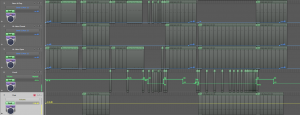
The only automation used in the drums is the change of the ‘repeat’ level on the ‘echo’ effect on the crash. The automation used changed how long the echo effect would last after the crash. This allowed me to make it longer after each chorus to fill out the sound more whilst everything had dropped out.
Here is a (compressed) bounce of all the drum parts with effects and automation on:
Basslines:
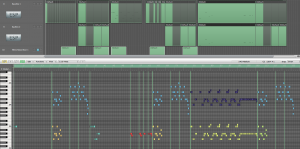
For the bassline, I layered two similar sounds together playing slightly different parts that work together to create a single sound.
Build 1:
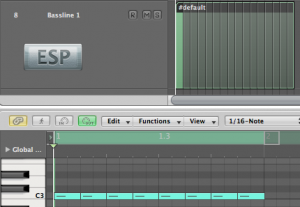
For the first build up, I had the first of the two sounds I was using playing a single C note on every eighth of a beat. This created a pad of sound that builds tension as it doesn’t change pitch or note at all.
Build 2:
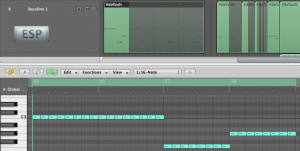
For the first part of the second build, I had the same sound as the first build, playing the same rhythm, however, it changes note from C for the first two bars, and then F for next bar, before finally moving into a G#, following the chord structure of the song, playing the route notes of each chord.
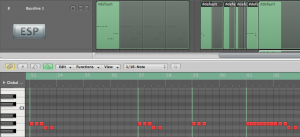
I then dropped out everything apart from the bassline and the clap and crash. This allowed me to make the bassline stand out a lot more than usual, giving a much harder hitting feel.
Build 3:


In the third build, I layered both bassline sounds with a low-pass/high-cut filter that slowly lifted off, to give it a ‘muffled’ sound that got cleaner, giving the build an open, softer feel, that gives a break to the rest of the song, which is mostly hard hitting basslines. I also created a riff that gets more rhythmically intricate as it goes on. This helps to build tension as it gives the build an open feeling to start with, that then closes off to fill out the sound more. I also then, at the end of the build, made the riff drone on the same note to build tension, like I did in the first build.
Chorus/Drop:
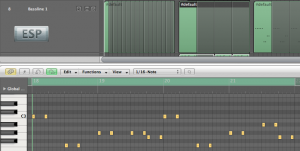
This is the same sound that I used in every build, its designed to accent the bass of the riff, playing the same riff shown above the entire way through the chorus.
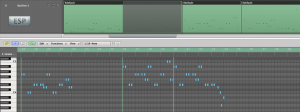
This sound however, is designed to accent the higher frequencies of the riff. This sound also plays a slightly different part to the first sound, it plays the same notes, but an octave and a fifth above the first sound, until half way through the chorus, where it plays another 3 semitones above what it was playing before (as well some other slight changes that deal with harmonic inconsistencies). At the end of the chorus, the second sound also begins to drop through into lower notes that allows the chorus to transition into the next build a lot smoother.
Effects & Automation:

The effects I used were used to create the sound I wanted for the bassline. For example, I used ensemble to give the bassline a thicker and more pleasant sound, and the EQ was used to accent the different frequencies that each part was using.



The automation I used consisted of volume and cutoff frequencies. This was to accent the builds by increasing the volume and opening the cutoffs as the tension builds uip to the drop.
Here is a bounce of the first bassline sound with the drums compared to both bassline sounds with the drums, so that you can see the difference with the extra layered sound. There is also a bounce of the bassline without drums. (All these bounces now include FX and automation)
Piano:
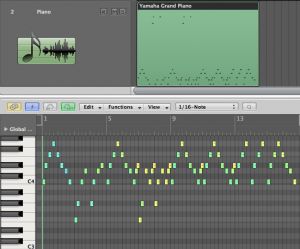

The Piano plays the same part during every build up and the outro. It arpeggiates through the chord progression, unless its being used in a build, as it will eventually begin to repeat a part of the arpeggio to build tension coming up to the drop.
Effects:
![]()
The effects on the piano part only really consists of the reverb and the EQ, which are only there to accent the highs and blend the piano into the rest of the song more.
Here is a bounce of the piano alongside all the other parts mentioned so far:
Risers:

The risers have no melodic or harmonic effect on the track, their sole purpose is to help build tension and fill out the sound more.




The automation and effects on the risers are what actually create the risers. The increasing volume up to the point where the risers should peak is what gives it that slow steady rise of noise. The cutoff frequency increasing gave the risers a sound that opens up more as it gets closer to the peak. The last bit of automation just allowed me to increase the amount of delay I was using, which allowed me to fill out the space a bit more in between the chorus and the builds.
Here is a bounce of the risers alongside all the other parts mentioned so far:
Deep Bass:

Finally, to gave the drop a much heavier hitting feel, I added some deep bass. There are two deep bass parts, just like the bassline parts, but an octave down and designed to only add the deep bass I wanted.

The effects I used (EQ and Enveloper) just ensured that all I was getting from these channels was the deep bass I wanted, as well as giving the deep bass a similar sound to a slowed down bass drum.
Here is a bounce of everything, with all the effects and automation, except the vocals: